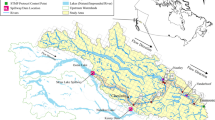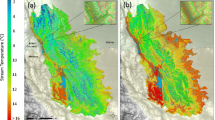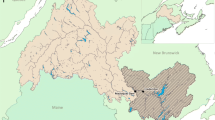Abstract
We examine summer temperature patterns in the Wenatchee River and two of its major tributaries Icicle and Nason Creeks, located in the Pacific Northwest region of the United States. Through model simulations we evaluate the cooling effects of mature riparian vegetation corridors along the streams and potential increases due to global warming for the 2020s–2080s time horizons. Site potential shade influences are smaller in the mainstream due to its relatively large size and reduced canopy density in the lower reaches, proving a modest reduction of about 0.3°C of the stream length average daily maximum temperature, compared with 1.5°C and 2.8°C in Icicle and Nason Creeks. Assuming no changes in riparian vegetation shade, stream length-average daily maximum temperature could increase in the Wenatchee River from 1–1.2°C by the 2020s to 2°C in the 2040s and 2.5–3.6°C in the 2080s, reaching 27–30°C in the warmest reaches. The cooling effects from the site potential riparian vegetation are likely to be offset by the climate change effects in the Wenatchee River by the 2020s. Buffers of mature riparian vegetation along the banks of the tributaries could prevent additional water temperature increases associated with climate change. By the end of the century, assuming site potential shade, the tributaries could have a thermal condition similar to today’s condition which has less shade. In the absence of riparian vegetation restoration, at typical summer low flows, stream length average daily mean temperatures could reach about 16.4–17°C by the 2040s with stream length average daily maxima around 19.5–20.6°C, values that can impair or eliminate salmonid rearing and spawning. Modeled increases in stream temperature due to global warming are determined primarily by the projected reductions in summer streamflows, and to a lesser extent by the increases in air temperature. The findings emphasize the importance of riparian vegetation restoration along the smaller tributaries, to prevent future temperature increases and preserve aquatic habitat.
Similar content being viewed by others
References
Andonaegui C (2001) Salmon, steelhead, and bull trout habitat limiting factors for the Wenatchee Subbasin (Water Resource Inventory Area 45) and portions of WRIA 40 within Chelan County. Final report, November 2001. Washington State Conservation Commission, Olympia
Brown LC, Barnwell TO (1987) The enhanced stream water quality models QUAL2E and QUAL2E-UNCAS: documentation and user manual. EPA/600/3-87/007
Chapra SC (1997) Surface water quality modeling. McGraw-Hill, New York
Chapra SC, Pelletier GJ (2003) QUAL2K: a modeling framework for simulating river and stream water quality: documentation and users manual. Civil and Environmental Engineering Dept., Tufts University, Medford, MA
Chen DY, Carsel RF, McCutcheon SC, Nutter WL (1998a) Stream temperature simulation of forested riparian areas: I. Watershed-scale model development. J Environ Eng 124(4):316–328
Chen DY, McCutcheon SC, Norton DJ, Nutter WL (1998b) Stream temperature simulation of forested riparian areas: II. Model application. J Environ Eng 124(4):316–328
Danehy RJ, Colson CG, Parrett KB, Duke SD (2005) Patterns and sources of thermal heterogeneity in small mountain streams within a forest setting. For Ecol Manag 208:287–302
Ebersole JL, Liss WL, Frissell CA (2001) Relationship between stream temperature, thermal refugia and rainbow trout Oncorhynchus mykiss abundance in arid-land streams in the northwestern United States. Ecol Freshw Fish 10:1–10
Ecology (2003) Shade.xls: a tool for estimating shade from riparian vegetation. Washington State Department of Ecology, Olympia
Edinger JE, Brady DK, Geyer JC (1974) Heat exchange and transport in the environment. EPRI publication no. 74-049-00-3, Electric Power Research Institute, Palo Alto, CA
Elsner MM, Cuo L, Voisin N, Deems J, Hamlet AF, Vano J, Mickelson KEB, Lee SY, Lettenmaier DP (2009) Implications of 21st century climate change for the hydrology of Washington State. In: Chapter 3.1 in the Washington climate change impacts assessment: evaluating Washington’s future in a changing climate, climate impacts group. University of Washington, Seattle, Washington
Frissell CA (1992) Cumulative effects of land use on salmonid habitat on southwest Oregon streams. Ph.D. thesis, Oregon State University, Corvalis, OR
Gooseff MN, Strzepek K, Chapra SC (2005) Modeling the potential effects of climate change on water temperature downstream of a shallow reservoir, Lower Madison River, MT. Clim Change 68:331–353
Hamlet AF, Lettenmaier DP (1999) Effects of climate change on hydrology and water resources in the Columbia River Basin. J Am Water Resour Assoc 35(6):1597–1623
Hamlet AF, Mote PW, Clark M, Lettenmaier DP (2005) Effects of temperature and precipitation variability on snowpack trends in the western U.S. J Clim 18(21):4545–4561
Hicks M (2002) Evaluating standards for protecting aquatic life in Washington’s surface water quality standards—temperature criteria—draft discussion paper and literature summary. Washington State Department of Ecology, Olympia, WA. Publication Number 00-10-070
Hoshi K, Stedinger JR, Burges SJ (1984) Estimation of log-normal quantiles: Monte Carlo results and first order approximations. J Hydrol 71:1–30
Johnson SL (2004) Factors influencing stream temperatures in small streams: substrate effects and a shading experiment. Can J Fish Aquat Sci 61(6):913–923
Johnson SL, Jones JA (2000) Stream temperature responses to forest harvest and debris flows in Western Cascades, Oregon. Can J Fish Aquat Sci 57(Suppl. 2):30–39
Lewis TE, Lamphear DR, McCanne DR, Webb AS, Krieter JP, Conroy WD (2000) Executive summary: regional assessment of stream temperatures across Northern California and their relationship to various Landscape-level and site-specific attributes. In: Forest Science Project. Humboldt State University Foundation, Arcata, CA, p 14
Liang X, Lettenmaier DP, Wood EF, Burges SJ (1994) A simple hydrologically based model of land surface water and energy fluxes for general circulation models. J Geophys Res 99(D7):14,415–14,428
Mantua NJ, Tohver I, Hamlet AF (2009) Impacts of climate change on key aspects of freshwater salmon habitat in Washington State. In: Chapter 6 in the Washington climate change impacts assessment: evaluating Washington’s future in a changing climate, climate impacts group. University of Washington, Seattle, Washington
McCullough D (1999) A review and synthesis of effects of alterations to the water temperature regime on freshwater life stages of salmonids, with special reference to Chinook Salmon. Columbia Intertribal Fisheries Commission, Portland, OR. Prepared for the U.S. Environmental Protection Agency Region 10. Published as EPA 910-R-99-010
Mohseni OS, Stefan HG, Erickson TR (1998) A nonlinear regression model for weekly stream temperatures. Water Resour Res 34:2685–2692
Mohseni OS, Stefan HG, Eaton JG (2003) Global warming and potential changes in fish habitat in U.S. streams. Clim Change 59:389–409
Payne JT, Wood AW, Hamlet AF, Palmer RN, Lettenmaier DP (2004) Mitigating the effects of climate change on the water resources of the Columbia River basin. Clim Change 62(1–3):233–256
Pelletier GJ, Chapra SC, Tao H (2006) QUAL2Kw—A framework for modeling water quality in streams and rivers using a genetic algorithm for calibration. Environ Model Softw 21:419–425
Scholz J (2001) The variability in stream temperatures in the Wenatchee National Forest and their relationship to physical, geological, and land management factors. University of Washington, M.S. Thesis
Sinokrot BA, Gulliver JS (2000) In-stream flow impact on river water temperatures. J Hydraul Res 38(5):339–349
Sinokrot BA, Stefan HG (1993) Stream temperature dynamics: measurements and modeling. Water Resour Res 29(7):2299–2312
SRES (Special Report on Emissions Scenarios) (2000) In: Nakicenovic N, Swart R (eds) Intergovernmental panel on climate change special report on emissions scenarios. Cambridge University Press, Cambridge, United Kingdom, p 612
Washington Department of Fisheries (1990) Wenatchee River subbasin Salmon and steelhead production plan. Olympia, WA
Whiley AJ (2003) Wenatchee national forest water temperature total maximum daily load. Washington Department of Ecology Technical Report. http://www.ecy.wa.gov/pubs/0310063.pdf. Cited 15 Aug 2005
Wright SA, Holly FM, Bradley AA, Krajewski W (1999) Long-term simulation of thermal regime of Missouri River. J Hydraul Eng 125(3):242–251
Author information
Authors and Affiliations
Corresponding author
Rights and permissions
About this article
Cite this article
Cristea, N.C., Burges, S.J. An assessment of the current and future thermal regimes of three streams located in the Wenatchee River basin, Washington State: some implications for regional river basin systems. Climatic Change 102, 493–520 (2010). https://doi.org/10.1007/s10584-009-9700-5
Received:
Accepted:
Published:
Issue Date:
DOI: https://doi.org/10.1007/s10584-009-9700-5




